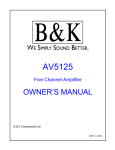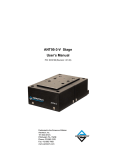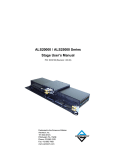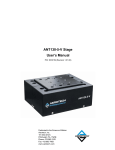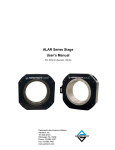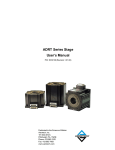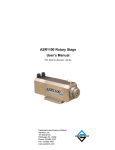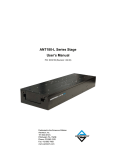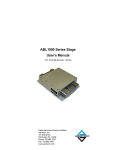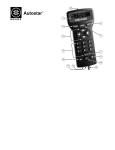Download ATS125 Series Stage User`s Manual
Transcript
ATS125 Series Stage User’s Manual P/N: EDS101 (Revision 1.02.00) Dedicated to the Science of Motion Aerotech, Inc. 101 Zeta Drive, Pittsburgh, PA, 15238 Phone: 412-963-7470 Fax: 412-963-7459 www.aerotech.com Product Registration Register online at: http://www.aerotech.com/prodreg.cfm Technical Support United States Headquarters: Phone: (412) 967-6440 Fax: (412) 967-6870 Email: [email protected] United Kingdom: Phone: +44 118 940 9400 Fax: +44 118 940 9401 Email: [email protected] Germany: Phone: +49 911 967 9370 Fax: +49 911 967 93720 Email: [email protected] Japan: Phone: +81(0)47-489-1741 (Sales) Phone: +81(0)47-489-1742 (Service) Fax: +81(0)47-489-1743 Email: [email protected] China: Phone: +852-3793-3488 Email: [email protected] Revision History Revision 1.02.00 November 19, 2010 Revision 1.01.00 February 11, 2008 Revision 1.00.00 February 10, 2008 Product names mentioned herein are used for identification purposes only and may be trademarks of their respective companies. © Aerotech, Inc. 2010 ATS125 Series Stage User's Manual Table of Contents Table of Contents Table of Contents List of Figures List of Tables iii v vii Chapter 1: Overview 1 1.1. Standard Features 1.1.1. Optional Features 1.1.2. Model Numbers 1.2. Safety Procedures and Warnings 1.3. EC Declaration of Incorporation Chapter 2: Installation 2.1. Unpacking and Handling the Stage 2.2. Preparing the Mounting Surface 2.3. Securing the Stage to the Mounting Surface 2.4. Attaching the Payload to the Stage 2.5. Electrical Installation 2.5.1. Standard Aerotech Motor options 2.5.2. Motor Foldback Options 2.5.3. Optical Limit Switches 2 3 4 6 8 9 9 10 11 12 13 13 15 15 Chapter 3: Operating Specifications 17 3.1. Environmental Specifications 3.2. Accuracy and Temperature Effects 3.3. Basic Specifications 3.4. Load Capability 3.5. Optical Limit Switch 3.5.1. Limit Switch Operation 3.5.2. Limit Switch Wiring 3.6. Standard Motor Wiring 3.7. Vacuum Operation 3.7.1. Special Guidelines 17 17 18 20 23 23 24 25 30 30 Chapter 4: Maintenance 4.1. Service and Inspection Schedule 4.2. Cleaning and Lubrication 4.2.1. Recommended Lubricants and Cleaning Solvents 4.2.2. Important Notes on Lubrication 4.3. Lubrication and Cleaning Process 4.4. Belt Adjustment (Foldback Motor Option) 31 31 32 32 32 33 34 Appendix A: Warranty and Field Service 35 Appendix B: Technical Changes 37 Index 39 Reader's Comments 40 www.aerotech.com iii Table of Contents iv ATS125 Series Stage User's Manual www.aerotech.com ATS125 Series Stage User's Manual List Of Figures List of Figures Figure 1-1: Figure 1-2: Figure 1-3: Figure 2-1: Figure 2-2: Figure 2-3: Figure 3-1: Figure 3-2: Figure 3-3: Figure 3-4: Figure 3-5: Figure 3-6: Figure 3-7: Figure 3-8: Figure 3-9: Figure 4-1: Figure 4-2: Typical ALS2500 Series Linear Positioning Stage ATS125 with Cutaway View of Ballscrew Two (XZ) and Three (XYZ) Axis Positioning Systems using ATS125 stages Results of Flat Versus Non-Flat Mounting Top view of an ATS125 Stage Showing Mounting Holes Components of a Typical ATS125 Stage Load Capability of ATS125 Series Stages Stage Orientations for LVC and LSC Torque Required to Turn ATS125 Ballscrew with Various Loads Internal View of a Typical Stage Showing Limit Switches ATS125 Series 9-pin Limit Switch Wiring (Foldback Equipped Stages Only) Normally Closed (NC) and Normally Open (NO) Limit Switch Wiring Feedback Wiring for Standard ATS125 Stages with Integral Motor Motor Wiring Connector for all ATS125 Stages Brake and Encoder Connector for Stages with Foldback Option Hardcover Removal Procedure Belt Access and Adjustment on Foldback Models www.aerotech.com 1 2 3 10 11 14 20 21 22 23 24 24 26 27 28 33 34 v List of Figures vi ATS125 Series Stage User's Manual www.aerotech.com ATS125 Series Stage User's Manual List of Tables List of Tables Table 1-1: Table 3-1: Table 3-2: Table 3-3: Table 3-4: Table 3-5: Table B-1: Table B-2: Model Numbering System Environmental Specifications ATS125 Series Specifications ATS125 Series Resolution Information ATS125 Motor Specifications Motor Wiring Pinout Descriptions Current Changes (1.02.00) Archived Changes www.aerotech.com 5 17 18 18 19 29 37 38 vii List of Tables viii ATS125 Series Stage User's Manual www.aerotech.com ATS125 Series Stage User's Manual Overview Chapter 1: Overview This manual describes Aerotech’s ATS125 series of linear motor positioning stages. Figure 1-1 shows a typical ATS125 positioning stage. The ATS125 series stages have travel distances ranging from 50 to 600 mm. The ATS125 is Aerotech's smallest hard cover, side-sealed stage design. The brushless integral motor option reduces the overall footprint of the stage enabling its use in space-constrained applications. This chapter introduces standard and optional features of the ATS125 stages, explains the model numbering system, and gives general safety precautions. Figure 1-1: Typical ALS2500 Series Linear Positioning Stage N O T E : Aerotech continually improves its product offerings, and listed options may be superseded at any time. Refer to the most recent edition of the Aerotech Motion Control Product Guide for the most current product information at www.aerotech.com. www.aerotech.com Chapter 1 1 Overview ATS125 Series Stage User's Manual 1.1. Standard Features The 5 mm lead ballscrew and Linear Motion Guide (LMG) are standard features on all stages (see Figure 12). The precision-ground, preloaded ballscrew ensures superior positioning resolution and accuracy while the LMG bearing system provides stiffness, good load carrying capabilities, and continuous load support over the entire range of travel. Other standard design features include an integral hardcover and side seals to keep contamination out of the internal mechanism, and integral wipers on the ballscrew nut and bearing trucks to further reduce contamination. Optical limit switches and mechanical end stops to protect the stage table from over-travel are also standard. Figure 1-2: 2 ATS125 with Cutaway View of Ballscrew Chapter 1 www.aerotech.com ATS125 Series Stage User's Manual Overview 1.1.1. Optional Features Available assembly options allow the ATS125 series stages to be configured for a variety of applications. A foldback option is available for use in space-constrained applications. In addition, any motor with a NEMA 23 frame size and 6.35mm (1/4”) or 9.53mm (3/8”) shaft can be mounted to the stage when using the foldback option. The stage table is available with the mounting holes and grid pattern in either English or metric dimensions. ATS125 stages can be easily assembled in XY axis arrangements. Available L-bracket accessories allow the stages to be mated to form XZ or XYZ axis arrangements. Multi-axis combinations can be optionally aligned to either 10 or 5-arc sec orthogonality. Optional wipers can be installed to the stage table to prevent accumulation of debris on the hard cover which could potentially become lodged between the cover and table. There are two rotary encoder options for stages equipped with integral motors. The two options are a 1000 line amplified sine encoder and a 2500 line driver encoder. For vacuum applications, two vacuum preparation options are available upon request, one compatible with low vacuum environments (down to 10-3 torr) and the other for high vacuum (10-3 to 10-6 torr) applications. Figure 1-3: www.aerotech.com Two (XZ) and Three (XYZ) Axis Positioning Systems using ATS125 stages Chapter 1 3 Overview ATS125 Series Stage User's Manual 1.1.2. Model Numbers Stage model number example: ATS125-050-TTM-5MM-NC-IM2500H-3-PLOTS The table below lists the available options in the order they appear in the example above. Aerotech continually improves its product offerings, and listed options may be superseded at any time. Refer to the most recent edition of the Aerotech Motion Control Product Guide for the most current product information at www.aerotech.com. 4 Chapter 1 www.aerotech.com ATS125 Series Stage User's Manual Table 1-1: Overview Model Numbering System Travel Options ATS125-050 50 mm travel stage with ballscrew and limits ATS125-100 100 mm travel stage with ballscrew and limits ATS125-150 150 mm travel stage with ballscrew and limits ATS125-200 200 mm travel stage with ballscrew and limits ATS125-250 250 mm travel stage with ballscrew and limits ATS125-300 300 mm travel stage with ballscrew and limits ATS125-400 400 mm travel stage with ballscrew and limits ATS125-500 500 mm travel stage with ballscrew and limits ATS125-600 600 mm travel stage with ballscrew and limits Tabletop Options -TTM Metric hole-pattern tabletop -TTU English hole-pattern tabletop -NOTT No Tabletop -TTM/WIPER Metric hole-pattern tabletop with wipers -TTU/WIPER English hole-pattern tabletop with wipers Drive Screw -5MM 5 mm per revolution drive screw Limit Options -NC Normally-closed end of travel and home limit switches (standard) -NO Normally-open end of travel and home limit switches Integral Motor Options (based on Aerotech’s BMS60) -IM2500H Motor with 2500 line driver encoder -IM1000AS Motor with 1000 amplified sine encoder -IM2500H-BRK Motor with 2500 line driver encoder and 24 VDC holding brake -IM1000AS-BRK Motor with 1000 amplified sine encoder and 24 VDC holding brake -NOIM No integral motor; required with foldback option Orientation -3 Left cable exit -5 Right cable exit -8 Right side foldback -12 Left side foldback Options -PLOTS Accuracy, straightness, flatness plots -NOPLOTS No accuracy, straightness, or flatness plots -FB125[1/4”] Foldback kit for NEMA 23 motor with ¼” diameter shaft -FB125[3/8”] Foldback kit for NEMA 23 motor with 3/8” diameter shaft www.aerotech.com Chapter 1 5 Overview ATS125 Series Stage User's Manual 1.2. Safety Procedures and Warnings The following statements apply throughout this manual. Failure to observe these precautions could result in serious injury to those performing the procedures and damage to the equipment. This manual and any additional instructions included with the stage should be retained for the lifetime of the stage. To minimize the possibility of electrical shock and bodily injury or death, disconnect all electrical power prior to making any electrical connections. To minimize the possibility of electrical shock and bodily injury or death when any electrical circuit is in use, ensure that no person comes in contact with the circuitry when the stage is connected to a power source. To minimize the possibility of bodily injury or death, disconnect all electrical power prior to making any mechanical adjustments. Moving parts of the stage can cause crushing or shearing injuries. All personnel must remain clear of any moving parts. Improper use of the stage can cause damage, shock, injury, or death. Read and understand this manual before operating the stage. If the stage is used in a manner not specified by the manufacturer, the protection provided by the stage can be impaired. Stage cables can pose a tripping hazard. Securely mount and position all stage cables to avoid potential hazards. 6 Chapter 1 www.aerotech.com ATS125 Series Stage User's Manual Overview Do not expose the stage to environments or conditions outside the specified range of operating environments. Operation in conditions other than those specified can cause damage to the equipment. The stage must be mounted securely. Improper mounting can result in injury and damage to the equipment. Use care when moving the stage. Manually lifting or transporting stages can result in injury. Only trained personnel should operate, inspect, and maintain the stage. This stage is intended for light industrial manufacturing or laboratory use. Use of the stage for unintended applications can result in injury and damage to the equipment. Before using this stage, perform an operator risk assessment to determine the needed safety requirements. www.aerotech.com Chapter 1 7 Overview ATS125 Series Stage User's Manual 1.3. EC Declaration of Incorporation Manufactorer: Aerotech, Inc. 101 Zeta Drive Pittsburgh, PA 15238 USA herewith declares that the product: Aerotech, Inc. ATS125 Stage is intended to be incorporated into machinery to constitute machinery covered by the Directive 2006/42/EC as amended; does therefore not in every respect comply with the provisions of this directive; and that the following harmonized European standards have been applied: EN ISO 12100-1,-2:2003+A1:2009 Safety of machinery - Basic concepts, general principles for design ISO 14121-1:2007 Safety of machinery - Risk assessment - Par 1: Principles EN 60204-1:2005 Safety of machinery - Electrical equipment of machines - Part 1: General requirements and further more declares that it is not allowed to put the equipment into service until the machinery into which it is to be incorporated or of which it is to be a component has been found and declared to be in conformity with the provisions of the Directive 2006/42/EC and with national implementing legislation, i.e. as a whole, including the equipment referred to in this Declaration. Authorized Representative: Address: Manfred Besold AEROTECH GmbH Süd-West-Park 90 D-90449 Nürnberg Name: Position: Location: Date: 8 Alex Weibel / Engineer Verifying Compliance Pittsburgh, PA November 19, 2010 Chapter 1 www.aerotech.com ATS125 Series Stage User's Manual Installation Chapter 2: Installation This chapter describes the installation procedure for the ATS125 stage, including handling the stage properly, preparing the mounting surface to accept the stage, securing the stage to the mounting surface, attaching the payload, and making the electrical connections. Installation must follow the instructions in this chapter. Failure to follow these instructions could result in injury and damage to the equipment. 2.1. Unpacking and Handling the Stage Carefully remove the stage from the protective shipping container. Set the stage on a smooth, flat, and clean surface. This is a simple, yet very important step in maintaining the integrity of the stage. Each stage has a label listing the system part number and serial number. These numbers contain information necessary for maintaining or updating system hardware and software. Locate this label and record the information for later reference. If any damage has occurred during shipping, report it immediately. Improper stage handling could adversely affect the stage’s performance. Therefore, use care when moving the stage. Manually lifting or transporting the stage can result in injury. Lift the stage only by the base. Do not use the ballscrew or motor as lifting points. www.aerotech.com Chapter 2 9 Installation ATS125 Series Stage User's Manual 2.2. Preparing the Mounting Surface The mounting surface should be flat and have adequate stiffness in order to achieve the maximum performance from the ATS125. When an ATS125 series stage is mounted to a non-flat surface, the stage can be distorted as the mounting screws are tightened. This distortion will decrease the overall accuracy of the stage. To maintain accuracy, the mounting surface should be flat within 1µm per 50mm. Adjustments to the mounting surface must be done before the stage is secured. The effects of flatness on mounting are illustrated in Figure 2-1. Figure 2-1: Results of Flat Versus Non-Flat Mounting N O T E : The stage base is precision machined and verified for flatness prior to stage assembly at the factory. If machining is required to achieve the desired flatness, it should be performed on the mounting surface rather than the stage base. Shimming should be avoided if possible. If shimming is required, it should be minimized to improve the rigidity of the system. 10 Chapter 2 www.aerotech.com ATS125 Series Stage User's Manual Installation 2.3. Securing the Stage to the Mounting Surface If necessary, manually move the stage table to access the 6.5 mm (0.28 in) diameter mounting holes along the edges of the stage (refer to Figure 2-2). Install the appropriately sized mounting screws (M6 or 1/4") through the mounting holes and secure the stage to the mounting surface. Repeat this process for each set of mounting holes. The stage must be mounted securely. Improper mounting can result in injury and damage to the equipment. N O T E : The stage table may offer a considerable amount of resistance when it is moved manually. This is especially true if the stage is fitted with a motor assembly. N O T E : If the stage is not connected to a power source, and is not equipped with an optional brake, it should be possible to move the stage table by hand with steady even pressure. Do not attempt to manually move the stage if it is connected to a power source or includes an integrated brake. Figure 2-2: www.aerotech.com Top view of an ATS125 Stage Showing Mounting Holes Chapter 2 11 Installation ATS125 Series Stage User's Manual 2.4. Attaching the Payload to the Stage To prevent damage to payloads, test the operation of the stage before the payload is attached to the stage table. Proceed with the electrical installation and test the motion control system in accordance with the system documentation. Document all results for future reference. For information on electrical connections, refer to Section 2.5. The payload should be flat, rigid, and comparable to the stage in quality. N O T E : For valid system performance, the mounting interface should be flat within 1 µm per 50 mm. Refer to Chapter 3: Operating Specifications for information on cantilevered loads and load positioning. 12 Chapter 2 www.aerotech.com ATS125 Series Stage User's Manual Installation 2.5. Electrical Installation Electrical installation requirements will vary depending on stage options. Installation instructions in this section are for stages equipped with standard Aerotech motors intended for use with an Aerotech motion control system. Contact Aerotech for further information regarding stages that are otherwise configured. Aerotech motion control systems are adjusted at the factory for optimum performance. When the ATS125 series stage is part of a complete Aerotech motion control system, setup involves connecting a stage and motor combination to the appropriate drive chassis with the cables provided. Connect the provided cables to the motor and feedback connectors on the stage. Labels on the drive indicate the appropriate connections. Refer to your drive manuals and documentation for additional installation and operation information. In some cases, if the system is uniquely configured, a drawing showing system interconnects is supplied. Refer to Section 3.6. for standard motor wiring and connector pin outputs. Never connect or disconnect any electrical component or connecting cable while power is applied, or serious damage may result. The stage's protective ground is located on pin A4 of the motor connector. If you are using cables other than those provided by Aerotech, you must connect pin A4 to a ground connection. 2.5.1. Standard Aerotech Motor options An integral motor (BMS60) comes mounted to one end of the ATS125 stage. Refer to Figure 2-3. Motor/encoder combinations offered as standard with ATS125 series have rear housings with integral cables. These connecting ports convey motor power, encoder feedback, and limit switch signals to an appropriate hardware device (e.g. axis controller or amplifier.). The electrical wiring from the motor, encoder, and limit switches to these connecting ports is contained within the rear motor housing and has been completed at the factory. Refer to Chapter 3: Operating Specifications for standard motor wiring and connector pin outputs. www.aerotech.com Chapter 2 13 Installation ATS125 Series Stage User's Manual Figure 2-3: 14 Components of a Typical ATS125 Stage Chapter 2 www.aerotech.com ATS125 Series Stage User's Manual Installation 2.5.2. Motor Foldback Options When the foldback option is chosen, a motor with a standard NEMA 23 frame size may be used. Either a 6.35mm (1/4”) shaft or a 9.53mm (3/8”) shaft size can be specified when ordering the stage. The belt pulleys are attached to the motor shaft with two set screws. See Figure 4-2 for an illustration showing the location of the set screws as well as the entire pulley and belt power transfer system. 2.5.3. Optical Limit Switches ATS125 stages are equipped with a pair of optical limit switches. When the stage is ordered with an integral motor, the limit switch wiring passes through the motor housing and is integrated into the motor wiring. On models with the foldback option, the limit switch wiring passes through the side of the stage and into a 9-pin D connector. Refer to Chapter 3: Operating Specifications for a description of limit switch operation and wiring. www.aerotech.com Chapter 2 15 Installation 16 ATS125 Series Stage User's Manual Chapter 2 www.aerotech.com ATS125 Series Stage User's Manual Operating Specifications Chapter 3: Operating Specifications The surrounding environment and operating conditions can affect the performance and service life of the stage. This chapter provides information on ideal environmental and operating conditions. Also included are instructions for estimating load and torque required to turn the ballscrew given various loadings. 3.1. Environmental Specifications The environmental specifications for the ATS125 are listed in the following table. Table 3-1: Environmental Specifications Ambient Temperature Operating: 10° to 35° C (50° to 95° F) The optimal operating temperature is 20° C ±2° C (68° F ±4° F). If at any time the operating temperature deviates from 20° C degradation in performance could occur. Contact Aerotech for information regarding your specific application and environment. Storage: 0° to 40° C (32° to 104° F) in original shipping packaging Humidity Operating: 40 percent to 50 percent RH The optimal operating humidity is 50 percent RH. Storage: 30 percent to 60 percent RH, non-condensing in original packaging Altitude Operating: 0 to 2,000 m (0 to 6,562 ft) above sea level Contact Aerotech if your specific application involves use above 2,000 m or below sea level. Vibration Use the system in a low vibration environment. Excessive floor or acoustical vibration can affect stage and system performance. Contact Aerotech for information regarding your specific application. Dust Exposure The ATS125 stages have limited protection against dust, but not water. This equates to an ingress protection rating of IP50. Use Indoor use only Do not expose the stage to environments or conditions outside the specified range of operating environments. Operation in conditions other than those specified can cause damage to the equipment. 3.2. Accuracy and Temperature Effects The accuracy specification of ATS125 series stages is measured at the center of travel 45mm above the table with the stage in a horizontal position. The accuracy of the ballscrew is a key element in the overall positioning accuracy. A scale error can be expected if temperature of the ballscrew differs from 20° C (68° F). The greater the temperature difference, the greater the error. The temperature of the ballscrew depends on the speed and duty cycle of the stage. The faster the movement and higher the duty cycle, the more the stage accuracy will be affected by heat. www.aerotech.com Chapter 3 17 Operating Specifications ATS125 Series Stage User's Manual 3.3. Basic Specifications Basic ATS125 series positioning stage specifications are shown in Table 3-2. Resolution is dependent on ballscrew pitch, encoder resolution, and controller interpolation. For all ATS125 series stages, the ballscrew pitch is 5 mm per revolution. To increase resolution with the amplified sine (AS) encoder, the use of a controller multiplier is required. Table 1-2 shows resolutions available assuming a x4 controller multiplication. Motor specifications are given in Table 3-4. Table 3-2: ATS125 Series Specifications Travel Bidirectional Repeatability Straightness and Flatness Accuracy 50 100 150 200 250 ±1.0 µm ±1.0 µm ±1.0 µm ±1.0 µm ±1.0 µm 3 µm 5 µm 6 µm 10 µm 10 µm ±6 µm ±6 µm ±8 µm ±8 µm ±10 µm 5.2 kg (11.4 lb) 5.5 kg (12.1 lb) Horizontal Load 45.5 kg (100 lb) Axial Load 18.2 kg (40 lb) Stage Weight 4.2 kg (9.2 lb) 4.6 kg (10.1 lb) Max Screw Speed Travel 4.9 kg (10.8 lb) 60 rps 300 400 500 600 ±1.0 µm ±1.0 µm ±1.0 µm ±1.0 µm Straightness and Flatness 12 µm 16 µm 18 µm 20 µm Accuracy ±10 µm ±12 µm ±14 µm ±16 µm Bidirectional Repeatability Horizontal Load 45.5 kg (100 lb) Axial Load 18.2 kg (40 lb) Stage Weight Max Screw Speed 5.8 kg (12.8 lb) 6.5 kg (14.3 lb) 7.2 kg (15.9 lb) 7.8 kg (17.2 lb) 60 rps 60 rps 50 rps 50 rps •All performance specifications based on precision mounting surface flat to within ±.002mm/300mm and are measured on a single axis basis. •Repeatability and accuracy include linearity correction and minimum thermal change during measurement. •Vertical and axial loads subject to cantilever load restriction. •Selected motor and drive will limit performance specifications. •Consult factory for XY and alternate mounting configurations. Table 3-3: ATS125 Series Resolution Information Encoder Option 1000 amplified sine Travel/Step (1) 1.25 µm Steps/Revolution (1) 4000 2500 line driver .5 µm 10000 (1) Assumes times-4 interpolation by controller. 18 Chapter 3 www.aerotech.com ATS125 Series Stage User's Manual Table 3-4: Operating Specifications ATS125 Motor Specifications BMS60 Model Winding Designation -A Performance Specifications (1,5) Stall Torque, Continous (2) Peak Torque (3) Rated Speed Rated Power Output, Continuous Electrical Specifications Peak Current, Stall (2) (3) Torque Constant (4,8) Motor Constant (2,4) Resistance, 25 °C (line to line) Inductance (line to line) Maximum Bus Voltage Thermal Resistance Number of Poles 0.33 oz-in 46.2 N-m 1.31 oz-in 184.9 rpm 4,000 watts 112.0 Volts pk / krpm 19.0 (5) BEMF Constant (line to line, max) Continuous Current, Stall N-m Amp pk 2.3 Amp rms 1.6 Amp pk 9.2 Amp rms 6.5 N-m / Amp pk 0.14 oz-in / Amp pk 20.1 N-m / Amp rms 0.20 oz-in / Amp rms 28.4 N-m / √W 0.050 oz-in / √W 7.02 ohms 8.4 mH 1.30 VDC 340 °C / W 1.73 P 8 1. Performance is dependent upon heat sink configuration, system cooling conditions, and ambient temperature 2. Values shown @ 75 °C rise above a 25 °C ambient temperature, with housed motor mounted to a 250 mm x 250 mm x 6 mm aluminum heat sink 3. Peak torque assumes correct rms current, consult Aerotech 4. Torque Constant and Motor Constant specified at stall 5. All performance and electrical specifications +/- 10% 6. Maximum winding temperature is 100 °C, Thermistor trips at 100 °C 7. Ambient operating temperature range: 0 °C - 25 °C, consult Aerotech for performance in elevated ambient temperatures 8. All Aerotech amplifiers are rated Apk; use torque constant in N-m / Apk when sizing www.aerotech.com Chapter 3 19 Operating Specifications ATS125 Series Stage User's Manual 3.4. Load Capability It is recommended that application loads be symmetrically distributed whenever possible (i.e., the payload should be centered on the stage table and the entire stage should be centered on the support structure). With the stage lying flat (horizontal) and the application load vertically applied and symmetrically distributed, the maximum vertical load carrying capacity of ATS125 stages is 45.5 kg. If cantilevered loads are applied, refer to Figure 3-1 to find the maximum allowable load. In Figure 3-1, two curves are shown for different loading conditions. The Lvc or “vertical cantilever” curve is for situations where the stage is mounted in a vertical orientation and the payload is mounted to the table top with its center of gravity extended outward. The Lsc or “side cantilever” curve assumes a horizontal stage orientation. If a cantilevered load situation is used, first determine if it is a vertical cantilever or side cantilever system based on 3.4. Measure the cantilever length, then find the corresponding load value from Figure 3-1. Figure 3-1: 20 Load Capability of ATS125 Series Stages Chapter 3 www.aerotech.com ATS125 Series Stage User's Manual Figure 3-2: Operating Specifications Stage Orientations for L VC and LSC The approximate amount of torque required to turn the ballscrew of an ATS125 series stage can be found from Figure 3-3 or the following equation: For ATS125 series stages, the ballscrew efficiency is rated at 90% (0.90). Refer to Figure 3-3. The maximum axial load carrying capacity of ATS125 stages is 18.2 kg (40lb) www.aerotech.com Chapter 3 21 Operating Specifications Figure 3-3: 22 ATS125 Series Stage User's Manual Torque Required to Turn ATS125 Ballscrew with Various Loads Chapter 3 www.aerotech.com ATS125 Series Stage User's Manual Operating Specifications 3.5. Optical Limit Switch ATS125 series stages are provided with a pair of optical limit switch assemblies mounted to the bottom of the stage table. The limit switches signal when the stage table has reached its maximum useable travel distance in both directions. 3.5.1. Limit Switch Operation Each limit switch has a light source and detector mounted to a small printed circuit board. Each limit switchboard is mounted at the ends of the stage with their emitter–detector axes perpendicular to the direction of table motion. On a standard stage, the clockwise (CW) switch is located at the end opposite the motor. When movement of the stage table causes the blade mounted to the stage carriage, to break the light beam from the emitter to the detector, a CW or counterclockwise (CCW) limit signal is generated. The limit switch itself can be configured as normally closed (NC) or normally open (NO). If the stage is driven approximately 2.0 revolutions (10mm) beyond the electrical limit, it will encounter a mechanical stop. Although the operating speed of the stage may be relatively slow, damage to the stage could result. Figure 3-4: Internal View of a Typical Stage Showing Limit Switches N O T E : The terms clockwise (CW) and counterclockwise (CCW) refer to the direction of motor rotation while looking into the shaft of the motor. For ATS125 series stages, a clockwise (CW) rotation of the motor causes the stage table to move away from the motor. Counterclockwise (CCW) rotation of the motor causes the stage table to move toward the motor. The exception is if an optional "fold back" option is used, in which case the directions are reversed. www.aerotech.com Chapter 3 23 Operating Specifications ATS125 Series Stage User's Manual 3.5.2. Limit Switch Wiring Limit switches are open-collector, TTL–compatible, electro–optical devices powered by 5 Volts that change output states when the stage approaches its maximum travel distance and breaks the light beam. Since they are open-collector devices, they may be interfaced to 24V logic inputs. Each limit switch is mounted on a small printed circuit board. Standard ATS125 Stages include limit switch wiring integrated into one of the two main connectors, but stages with the foldback option include a separate 9-pin limit switch connector, detailed in Figure 3-5. Figure 3-5: ATS125 Series 9-pin Limit Switch Wiring (Foldback Equipped Stages Only) Assuming a NC limit configuration, the input to the controller is seen as a logic 0 (typical 0.4V @ 12.8mA) when no limit condition is present. When the limit switch is activated, a 5V source through a pull-up resistor causes a logic 1 (typically 4.8-5V) to be seen by the controller input. The limit switch operation for a NO limit configuration is the exact opposite as described above. See Figure 3-6Figure 3-6 for a diagram of limit switch wiring. Figure 3-6: 24 Normally Closed (NC) and Normally Open (NO) Limit Switch Wiring Chapter 3 www.aerotech.com ATS125 Series Stage User's Manual Operating Specifications 3.6. Standard Motor Wiring Stages fitted with standard motors and encoders come from the factory completely wired and assembled. For reference, connector pin outputs and general wiring information is given in the following figures. Pin outputs are defined in Table 3-5. N O T E : Refer to the other documentation accompanying your Aerotech equipment. Call your Aerotech representative if there are any questions on system configuration. N O T E : If you are using your own cables to connect the stage, ensure that the motor and ground wires can handle current higher than the continuous current listed in Table 3-4. The voltage rating of the wire insulation must be greater than the maximum bus voltage listed in Table 3-4. www.aerotech.com Chapter 3 25 Operating Specifications Figure 3-7: 26 ATS125 Series Stage User's Manual Feedback Wiring for Standard ATS125 Stages with Integral Motor Chapter 3 www.aerotech.com ATS125 Series Stage User's Manual Figure 3-8: www.aerotech.com Operating Specifications Motor Wiring Connector for all ATS125 Stages Chapter 3 27 Operating Specifications Figure 3-9: 28 ATS125 Series Stage User's Manual Brake and Encoder Connector for Stages with Foldback Option Chapter 3 www.aerotech.com ATS125 Series Stage User's Manual Table 3-5: Operating Specifications Motor Wiring Pinout Descriptions Pin Output Clockwise (CW/+) Limit Description Active high signal indicating maximum travel produced by CW motor rotation. Normally not used on ATS125 stage with standard limit switch wiring. CW Limit N Active low signal indicating stage maximum travel produced by CW motor rotation. COS Cosine. Incremental encoder output; either TTL line driven or amplified sine wave type signal. COS-N Incremental encoder output. Complement of cos. -LMT Active high signal indicating stage maximum travel produced by negative stage direction. Counterclockwise (CCW/-) Limit Active high signal indicating stage maximum travel produced by CCW motor rotation. CCW Limit N Active low signal indicating stage maximum travel produced by CCW motor rotation. HOME LMT Home Limit. Paralleled with CCW/- (with Standard Jumper) or CW/+ (Optional Jumper) limit. Typically not used. ENC +5V +5 V supply input for optical encoders. Typical requirement is 250 mA. ENC COM + 5 V return for optical encoders (ground). HA Hall Effect A. Brushless motor commutation track output. TTL line driven signal with rotary motor. HB Hall Effect B. Brushless motor commutation track output. TTL line driven signal with rotary motor. HC Hall Effect C. Brushless motor commutation track output. TTL line driven signal with rotary motor. LMT +5v + 5 V supply input for optical limit switch boards. Typical requirement is 50 mA. LMT COM + 5 V return for optical limit switch boards (ground). MKR Marker. Incremental encoder output pulse given once per revolution. Typically used for home reference cycle. MKR-N Incremental encoder output; either the compliment of Marker with a line driven, TTL type encoder or 2.5 V DC bias level with amplified sine wave type encoder. SIN Sine. Incremental encoder output; either TTL line driven or amplified sign wave type signal. SIN-N Incremental encoder output. Complement of sin. MTR ØA Motor Phase A. MTR ØB Motor Phase B. MTR ØC Motor Phase C. BRAKE + Brake +24 VDC, 250 mA. BRAKE - Brake 24 VDC Common. www.aerotech.com Chapter 3 29 Operating Specifications ATS125 Series Stage User's Manual 3.7. Vacuum Operation Aerotech will prepare the ATS125 series stage for operation in vacuum environments. Aerotech offers two vacuum preparation options; one for low vacuum (for use in atmospheric pressures to 10-3 torr) and one for high vacuum (preparation for environments from 10-3 to 10-6 torr). As part of this preparation, attention to detail during modification, cleaning, and assembly results in stages with optimal performance in vacuum applications. This chapter will outline preparation techniques for stages that will operate in a vacuum. Some techniques covered are: l Lubrication with vacuum–compatible lubricants l Use of materials, fasteners, and coatings with vacuum outgas performance compatible with the level of vacuum specified l For high vacuum stages, elimination of situations that may allow gases to become temporarily trapped during pump down l Extensive cleaning prior to assembly in a clean environment and packaging in a special polyethylene bag 3.7.1. Special Guidelines To ensure that the stage will continue to perform well in the vacuum environment, follow the guidelines listed below (in addition to standard handling, installation, and lubrication guidelines outlined earlier in this manual). 1. Do not remove the stage from the sealed bag until it is ready for use. 2. Always handle the stage in a clean environment and use powder-free polyethylene gloves to prevent any contaminants from adhering to the surface of the stage. 3. During installation, use cleaned, vented, stainless steel fasteners when securing the stage. 4. Reduced air pressure eliminates significant convective heat transfer. This, coupled with the viscous vacuum–compatible lubricants, could result in excessive motor operating temperatures. Because of this, consider all continuous torque ratings to be 40 to 60% lower than the value specified for operation in normal atmospheric environment. Reduce motor usage accordingly. 5. For vacuum applications, the recommended lubricant is a small quantity of Braycoteâ602EF grease or a substitute of equal quality. 6. Aerotech does not bake out vacuum components. Baking vacuum components between 100 and 125 °C for 24 to 48 hours significantly reduces outgassing at initial pump-down to vacuum pressure and evaporates water vapor that impregnates porous surfaces on the aluminum surfaces and Teflon cables. Aerotech recommends that customers bake out vacuum systems when first installing them in the vacuum chamber. 30 Chapter 3 www.aerotech.com ATS125 Series Stage User's Manual Maintenance Chapter 4: Maintenance This chapter will cover information about intervals between lubrications, detail the lubrication and inspection process, and cover which lubricants are recommended for use. Also included is a section on belt tension and adjustment on stages with the foldback option. N O T E : The bearing area must be kept free of foreign matter and moisture; otherwise, the performance and life expectancy of the stage will be reduced. Always operate the stage with the hard cover and side seals in place to help keep dirt out. To minimize the possibility of bodily injury, confirm that all electrical power is disconnected prior to making any mechanical adjustments. 4.1. Service and Inspection Schedule Lubricant inspection and replenishment in ATS125 series stages depends on conditions such as duty cycle, speed, and the environment. An inspection interval of once per month is recommended until a trend develops for the application. Longer or shorter intervals may be required to maintain the film of lubricant on the bearing surfaces. In general, it is recommended that stages operating in a clean environment be lubricated annually. For stages operating under conditions involving excessive debris, lubrication every six months is recommended. The ballscrew end bearings and motor bearings are sealed, and should not need to be relubricated under normal use. www.aerotech.com Chapter 4 31 Maintenance ATS125 Series Stage User's Manual 4.2. Cleaning and Lubrication 4.2.1. Recommended Lubricants and Cleaning Solvents For standard ballscrew assemblies and LMG guide rails, NSK LGU grease is recommended. If a solvent is necessary for cleaning the stage, it is recommended that isopropyl rubbing alcohol be used. Harsher solvents, such as acetone, may damage the plastic and rubber seals on the ballscrew or LMG trucks. For high-speed applications (i.e., near maximum speed at a duty cycle of 50%), frequent ballscrew maintenance with standard lubricants is required. 4.2.2. Important Notes on Lubrication When cleaning and/or lubricating components of the ATS125 series stages: 1. Be sure to use a clean, dry, soft, and lint–free cloth for cleaning. 2. Take the opportunity during the lubrication procedure to inspect the linear motion guides for any damage or signs of wear. 3. In applications that have multiple stages bolted together to form multiaxis systems, the orthogonality may be lost if the stage tables of the support stages are loosened. Precision aligned stages should not be loosened or disassembled. 4. Further disassembly of the stage is not recommended because proper assembly and calibration can only be done at the factory. In addition, a laser interferometer is required for post assembly verification to maintain warranties. 32 Chapter 4 www.aerotech.com ATS125 Series Stage User's Manual Maintenance 4.3. Lubrication and Cleaning Process The lubrication and cleaning process is outlined in the steps that follow. Before beginning lubrication, please see Section 4.2.1. for recommended lubricants. 1. Drive the stage table to one end of travel and remove power to the stage. 2. Remove the screws on the edges of the hard cover (Figure 4-1) and slide it out from the side opposite of the motor. This can be done without removing the table. 3. Remove any accumulated dust or debris from the inside of the assembly. 4. Remove any dirty or dried lubricant from the ballscrew. Use a clean, lint-free cloth with a side-to-side motion. Manually turn the ballscrew to clean its entire circumference. A swab soaked in Isopropyl Alcohol may be used to remove stubborn debris. 5. Clean the end of the ballscrew nut and wiper with a clean, lint-free cloth or swab. 6. Clean the linear bearing guides using a similar technique. 7. Apply a thin, continuous film of lubricant to the ballscrew threads and linear bearing guides. A good quality, natural bristle artist's brush makes an excellent applicator. 8. For stages without an optional brake, manually move the stage to the opposite end of travel. This will work the grease into the ballscrew and linear bearing guides. Depending on the pitch of the ballscrew, it may be necessary to turn the ballscrew by hand rather than simply push the stage manually. This can be done by turning the motor coupling. If the stage has an optional brake, the stage cannot be moved by hand. In this case, restore power to the stage, drive it to the desired position, then remove power and continue to step 9. Be sure to use extreme caution while operating the stage temporarily without the hardcover installed. 9. Repeat steps 3 through 7 for any areas covered by the original table position. 10. Refasten the hardcover. 11. Restore power to the stage, drive the stage table back to its original position to redistribute lubricants. To minimize the possibility of bodily injury, confirm that all electrical power is disconnected prior to making any mechanical adjustments. Figure 4-1: www.aerotech.com Hardcover Removal Procedure Chapter 4 33 Maintenance ATS125 Series Stage User's Manual 4.4. Belt Adjustment (Foldback Motor Option) On foldback stages, the motor torque is transferred to the ballscrew via a timing belt. Belt tension is critical to stage performance and accuracy. When lubricating and cleaning the stage, it is recommended that belt tension be checked. Deflection in the belt should be less than 5 mm when applying a downward force directly between the pulleys (as shown by the large arrow) of approximately 5 N. If deflection exceeds this range, the belt tension should be adjusted. The method of adjustment is outlined below. 1. Remove power to the stage. 2. Remove the four mounting screws for the foldback cover. 3. Check the tension in the belt (described above) to determine if adjustment is necessary 4. If adjustment is required, loosen (but do not remove) the four motor mounting screws as shown below by small angled arrows. 5. As shown below, the motor mounting holes are slotted to allow for belt adjustment. With all four screws loose, pull the motor away from the stage by hand until desirable belt tension is achieved. 6. Tighten motor mounting screws and re-check the tension in the belt. Belt tension may change after the mounting screws are tightened, so if necessary repeat step 5 until desired tension is reached. 7. While adjusting tension, it is advisable to verify that the pulleys are tight on their respective shafts. Each pulley is held in position with two set screws. If a pulley is loose, it may be necessary to tighten one or both of these screws. 8. Once tension adjustment is complete, replace the foldback cover and mounting screws. Restore power to the stage. N O T E : If the stage has been calibrated (HALAR), note the orientation of the two pulleys within regard to each other or recalibration might be required. Figure 4-2: 34 Belt Access and Adjustment on Foldback Models Chapter 4 www.aerotech.com ATS125 Series Stage User's Manual Warranty and Field Service Appendix A: Warranty and Field Service Aerotech, Inc. warrants its products to be free from defects caused by faulty materials or poor workmanship for a minimum period of one year from date of shipment from Aerotech. Aerotech's liability is limited to replacing, repairing or issuing credit, at its option, for any products that are returned by the original purchaser during the warranty period. Aerotech makes no warranty that its products are fit for the use or purpose to which they may be put by the buyer, where or not such use or purpose has been disclosed to Aerotech in specifications or drawings previously or subsequently provided, or whether or not Aerotech's products are specifically designed and/or manufactured for buyer's use or purpose. Aerotech's liability or any claim for loss or damage arising out of the sale, resale or use of any of its products shall in no event exceed the selling price of the unit. Aerotech, Inc. warrants its laser products to the original purchaser for a minimum period of one year from date of shipment. This warranty covers defects in workmanship and material and is voided for all laser power supplies, plasma tubes and laser systems subject to electrical or physical abuse, tampering (such as opening the housing or removal of the serial tag) or improper operation as determined by Aerotech. This warranty is also voided for failure to comply with Aerotech's return procedures. Laser Products Claims for shipment damage (evident or concealed) must be filed with the carrier Return Procedure by the buyer. Aerotech must be notified within (30) days of shipment of incorrect materials. No product may be returned, whether in warranty or out of warranty, without first obtaining approval from Aerotech. No credit will be given nor repairs made for products returned without such approval. Any returned product(s) must be accompanied by a return authorization number. The return authorization number may be obtained by calling an Aerotech service center. Products must be returned, prepaid, to an Aerotech service center (no C.O.D. or Collect Freight accepted). The status of any product returned later than (30) days after the issuance of a return authorization number will be subject to review. After Aerotech's examination, warranty or out-of-warranty status will be determined. If upon Aerotech's examination a warranted defect exists, then the product(s) will be repaired at no charge and shipped, prepaid, back to the buyer. If the buyer desires an airfreight return, the product(s) will be shipped collect. Warranty repairs do not extend the original warranty period. Returned Product Warranty Determination After Aerotech's examination, the buyer shall be notified of the repair cost. At such Returned Product time, the buyer must issue a valid purchase order to cover the cost of the repair and Non-warranty Deterfreight, or authorize the product(s) to be shipped back as is, at the buyer's mination expense. Failure to obtain a purchase order number or approval within (30) days of notification will result in the product(s) being returned as is, at the buyer's expense. Repair work is warranted for (90) days from date of shipment. Replacement components are warranted for one year from date of shipment. At times, the buyer may desire to expedite a repair. Regardless of warranty or outof-warranty status, the buyer must issue a valid purchase order to cover the added rush service cost. Rush service is subject to Aerotech's approval. www.aerotech.com Appendix A Rush Service 35 Warranty and Field Service ATS125 Series Stage User's Manual On-site Warranty If an Aerotech product cannot be made functional by telephone assistance or by Repair sending and having the customer install replacement parts, and cannot be returned to the Aerotech service center for repair, and if Aerotech determines the problem could be warranty-related, then the following policy applies: Aerotech will provide an on-site field service representative in a reasonable amount of time, provided that the customer issues a valid purchase order to Aerotech covering all transportation and subsistence costs. For warranty field repairs, the customer will not be charged for the cost of labor and material. If service is rendered at times other than normal work periods, then special service rates apply. If during the on-site repair it is determined the problem is not warranty related, then the terms and conditions stated in the following "On-Site Non-Warranty Repair" section apply. On-site Non-warranty If any Aerotech product cannot be made functional by telephone assistance or purRepair chased replacement parts, and cannot be returned to the Aerotech service center for repair, then the following field service policy applies: Aerotech will provide an on-site field service representative in a reasonable amount of time, provided that the customer issues a valid purchase order to Aerotech covering all transportation and subsistence costs and the prevailing labor cost, including travel time, necessary to complete the repair. Company Address Aerotech, Inc. 101 Zeta Drive Pittsburgh, PA 15238-2897 36 Phone: (412) 963-7470 Fax: (412) 963-7459 Appendix A www.aerotech.com ATS125 Series Stage User's Manual Technical Changes Appendix B: Technical Changes Table B-1: Current Changes (1.02.00) Section(s) Affected Section 1.3. General Information Added section Section 3.3. Added section Chapter 2: Installation, Section 2.1. , Section 2.3. , Section 2.5. , and Section 1.2. Added safety information and warnings Section 3.3. Added motor specifications Section 3.6. Added note about current requirements of motor and ground wires www.aerotech.com Appendix B 37 Technical Changes Table B-2: 38 ATS125 Series Stage User's Manual Archived Changes Revision 1.00.00 Section(s) Affected -- 1.01.00 Section 3.6. General Information New manual Encoder wiring graphic updated Appendix B www.aerotech.com Index ATS125 Series Stage User's Manual Index Multi-axis combinations 3 multiaxis combinations 32 A Attaching the Payload O 12 axis 3 B ball screw temperature of operating conditions 17 Optical Limit Switch 23 Optical limit switches 2 Optional Features 3 17 P C Preparing the Mounting Surface 10 cable 13 Cleaning 32 clockwise (CW) switch 23 safety procedures counterclockwise (CCW) switch 23 Securing the Stage to the Mounting Surface 11 CW and CCW terminology 23 Specifications 18 S 6 stage table D Declaration of Incorporation 3, 11 Standard Features 2 8 T E Electrical Installation temperature effects 13 encoders 17 travel distance 1 13, 25 Environmental Specifications U 17 Unpacking and Handling the Stage 9 L limit switches V 2 vacuum preperation lubricants recommended 30 32 W Lubrication 32 lubrication and cleaning 33 lubrication schedule 31 Warnings wiring 6 13, 24 M model numbers motors www.aerotech.com 9 13 Index 39 Reader's Comments ATS125 Series Stage Manual P/N: EDS101, November 19, 2010 Revision 1.02.00 Please answer the questions below and add any suggestions for improving this document. Is the manual: Yes No Adequate to the subject Well organized Clearly presented Well illustrated How do you use this document in your job? Does it meet your needs? What improvements, if any, would you like to see? Please be specific or cite examples. Stage/Product Details Name Model # Title Serial # Company Name Date Shipped Address Customer Order # Aerotech Subsidiary Order # Email Mail your comments to: Fax to: Aerotech, Inc. 101 Zeta Drive Pittsburgh, PA 15238 U.S.A. 412-967-6870 Email: [email protected]
















































